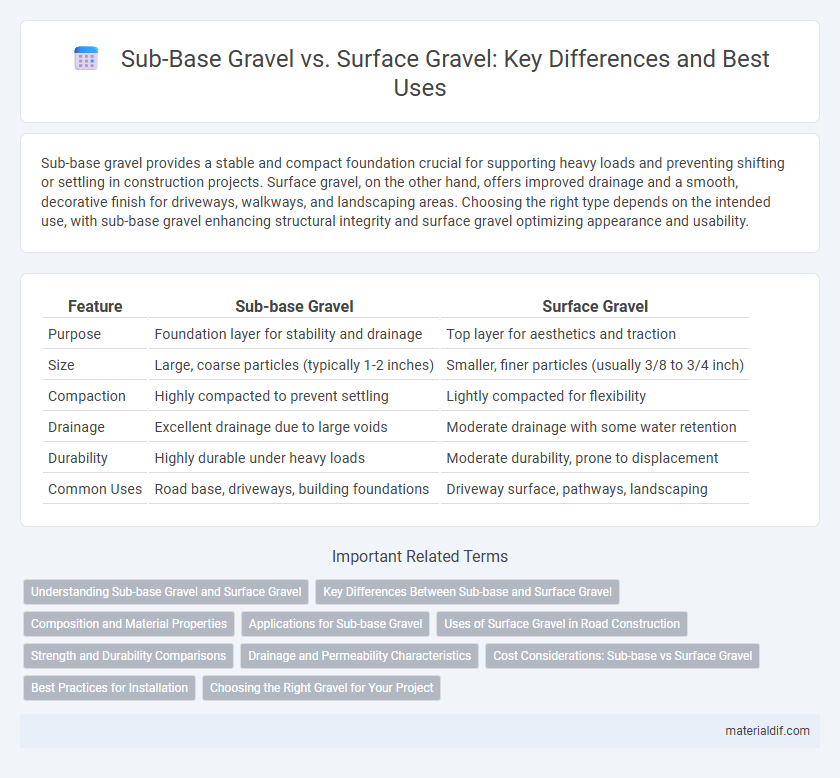Sub-base gravel provides a stable and compact foundation crucial for supporting heavy loads and preventing shifting or settling in construction projects. Surface gravel, on the other hand, offers improved drainage and a smooth, decorative finish for driveways, walkways, and landscaping areas. Choosing the right type depends on the intended use, with sub-base gravel enhancing structural integrity and surface gravel optimizing appearance and usability.
Table of Comparison
| Feature | Sub-base Gravel | Surface Gravel |
|---|---|---|
| Purpose | Foundation layer for stability and drainage | Top layer for aesthetics and traction |
| Size | Large, coarse particles (typically 1-2 inches) | Smaller, finer particles (usually 3/8 to 3/4 inch) |
| Compaction | Highly compacted to prevent settling | Lightly compacted for flexibility |
| Drainage | Excellent drainage due to large voids | Moderate drainage with some water retention |
| Durability | Highly durable under heavy loads | Moderate durability, prone to displacement |
| Common Uses | Road base, driveways, building foundations | Driveway surface, pathways, landscaping |
Understanding Sub-base Gravel and Surface Gravel
Sub-base gravel serves as a foundational layer providing stability and drainage beneath pavements or driveways, typically composed of larger, angular stones that compact well for structural support. Surface gravel, often smaller and rounded, forms the top layer designed for aesthetics and traction, commonly used in pathways and decorative landscaping. Understanding the difference ensures proper gravel selection for durability, drainage, and functional performance in construction and outdoor projects.
Key Differences Between Sub-base and Surface Gravel
Sub-base gravel consists of larger, coarse aggregates designed to provide strong structural support and proper drainage beneath paved or unpaved surfaces, while surface gravel is finer and smoother, intended to create a stable, aesthetically pleasing top layer for walkways, driveways, or roads. The key difference lies in their particle size and purpose: sub-base gravel ensures foundational stability and load distribution, whereas surface gravel offers traction, reduces dust, and enhances appearance. Proper selection between sub-base and surface gravel impacts durability, drainage efficiency, and overall performance of the constructed surface.
Composition and Material Properties
Sub-base gravel typically consists of larger, angular stones with a mixture of crushed rock and fines, providing strong compaction and load-bearing capacity essential for foundational support. Surface gravel, often composed of smaller, rounded stones or pea gravel, offers better drainage and a smoother finish suitable for walkways and driveways. The difference in particle size distribution and angularity directly influences durability, permeability, and overall stability in construction applications.
Applications for Sub-base Gravel
Sub-base gravel is primarily used as a stable foundation layer beneath roads, driveways, and patios, providing essential support and drainage to prevent shifting and erosion. It consists of larger, angular stones that compact well, ensuring a strong base to distribute loads evenly and enhance structural integrity. This gravel is essential in construction projects requiring durability and longevity, such as highways, parking lots, and heavy-use pathways.
Uses of Surface Gravel in Road Construction
Surface gravel in road construction provides a durable, skid-resistant layer that enhances vehicle traction and safety on paved and unpaved roads. It is commonly used as the topmost layer on driveways, rural roads, and pathways to improve water drainage and minimize surface erosion. Unlike sub-base gravel, surface gravel must be angular and well-graded to ensure proper compaction and resistance to displacement under traffic loads.
Strength and Durability Comparisons
Sub-base gravel typically consists of large, crushed stones that provide a strong, stable foundation with excellent load-bearing capacity, essential for infrastructure projects. Surface gravel, usually made of smaller, angular stones, offers better traction and wear resistance but is less durable under heavy loads compared to sub-base gravel. The strength and durability of sub-base gravel make it ideal for supporting pavements, while surface gravel is optimized for top-layer applications requiring resistance to weathering and traffic abrasion.
Drainage and Permeability Characteristics
Sub-base gravel features larger, crushed stones that create high permeability, promoting efficient drainage and preventing water accumulation beneath pavement structures. Surface gravel consists of smaller, rounded particles designed to provide a stable, erosion-resistant layer with moderate drainage properties, suitable for roads and driveways. The key difference lies in sub-base gravel's superior ability to facilitate water flow through the base, reducing hydrostatic pressure, while surface gravel balances permeability with surface durability.
Cost Considerations: Sub-base vs Surface Gravel
Sub-base gravel typically costs less per ton than surface gravel due to its lower quality requirements and coarser material, making it ideal for foundational layers in construction. Surface gravel is usually more expensive because it needs to be smoother, more durable, and visually appealing, often involving higher-grade aggregates like crushed stone or river rock. Budgeting for gravel installation must consider these cost differences alongside the project's structural and aesthetic needs to ensure long-term value and performance.
Best Practices for Installation
Sub-base gravel should be installed with properly compacted layers of crushed stone to create a stable foundation that promotes drainage and prevents shifting. Surface gravel requires a finer, well-graded aggregate spread evenly and compacted to provide a smooth, durable finish that resists erosion. Best practices include using appropriate gravel sizes for each layer and ensuring thorough compaction to maximize longevity and performance.
Choosing the Right Gravel for Your Project
Sub-base gravel provides a strong, stable foundation by offering excellent drainage and compaction, essential for supporting heavy loads in construction and road projects. Surface gravel, often smoother and more decorative, is ideal for pathways, driveways, and landscaping, enhancing appearance while providing traction. Selecting the right gravel depends on factors such as load requirements, drainage needs, and aesthetic goals, ensuring durability and functionality for your specific project.
Sub-base Gravel vs Surface Gravel Infographic

 materialdif.com
materialdif.com